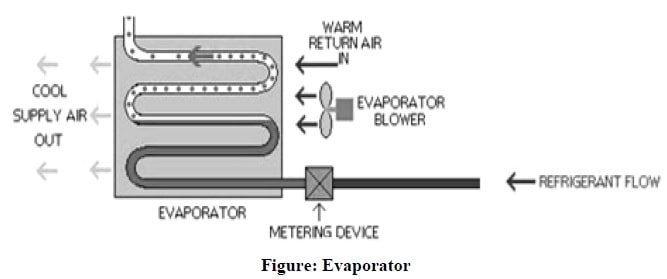
Before you read the passage, talk about these questions.
1) What do you know about evaporator?
2) What types of evaporators do you know?
Evaporator
The function of the evaporator is to absorb the heat from the space or surrounding medium which is to be cooled by means of refrigeration. The process of heat removal from the substance to be cooled or refrigerated is done in the evaporator. The liquid refrigerant is vaporized inside the evaporator (coil or shell) in order to remove heat from a fluid such as air, water etc. Evaporators are manufactured in different shapes, types and designs to suit a diverse nature of cooling requirements. Thus, we have a variety of types of evaporators, such as prime surface types, finned tube or extended surface type, shell and tube liquid chillers, etc.
The evaporator as shown in the figure is the part of the refrigeration system where the refrigerant vaporizes as it picks up heat. Heated air is forced through and past the fins and tubes of the evaporator. The heat from the air is picked up by the boiling refrigerant and is carried in the system to the condenser. The evaporator is usually installed in housing under the dash panel.
 Evaporator Diagram
Evaporator Diagram
When the air conditioning system is turned on, warm air from the
passenger compartment is blown through the coils and fins of the evaporator.
The evaporator receives refrigerant from the thermostatic expansion valve
or orifice tube as low pressure, cold atomized liquid. As the cold refrigerant
passes through the evaporator coil, heat moves from the warm air
into the cooler refrigerant. When the liquid refrigerant receives enough heat,
a change of state – from a low-pressure liquid into a low-Pressure vapor –
takes place.
The thermostatic expansion valve or orifice tube continually meters the precise amount of refrigerant necessary to maintain optimum heat transfer, which ensures that all of the liquid refrigerants will have changed to a vapor by the time it reaches the evaporator outlet. The vaporized refrigerant then continues on to the inlet (suction) side of the compressor.
Evaporators are divided mainly into three groups.
1. Natural circulation evaporator
) Evaporating pans
ii) Evaporating stills
iii) Short tube evaporator.
2) Forced circulation evaporator.
3) Film evaporator
Types:
i) Wiped Film evaporator
ii) Long Tube Evaporator
a) Climbing film evaporator
b) Falling film evaporator Types of Evaporators.
Flooded type of evaporator feeds excess of liquid refrigerant so that the exit of the evaporator will be a mixture of liquid and vapor refrigerant.

Flooded type evaporator diagram
In the flooded type of evaporator coil remains completely filled with liquid refrigerant as shown in the figure. The level of liquid refrigerant is maintained constant in the surge chamber by using float control. The liquid refrigerant enters into evaporator coil from the surge chamber. In evaporator coil, part of liquid refrigerant boils and converts into vapor. The vapor formed is collected at the top of the surge chamber and the remaining liquid refrigerant is returned to the surge chamber.
From the top of the surge chamber, refrigerant vapors are drawn in the suction line of the compressor. In the flooded type evaporator rate of heat transfer is very high as the whole evaporator coil remains in contact with liquid refrigerant but this type of refrigerant requires a large amount of refrigerant.
Applications of flooded type evaporator:-
This
type of evaporator is used for
1) Large installations, where refrigerating capacity is high.
2) In a refrigeration system where load fluctuation is higher.
3) For multi evaporator system.
1. Write out the underlined words and phrases, and translate them from English into Russian.
2. Answer the following questions:
1) What is the function of the evaporator?
2) Where is evaporator usually installed in housing?
3) What are the main types of evaporator?
4) What’s happened when the air conditioning system is turned on?
5) What is flooded type evaporator used for?
3. Complete the following sentences:
1) The vaporized refrigerant then continues … .
2) From the top of the surge chamber, refrigerant vapors are drawn … .
3) The liquid refrigerant enters into evaporator coil … .
4) Evaporators are manufactured in different shapes, … .
5) As the cold refrigerant passes through the evaporator coil, … .
Материалы на данной страницы взяты из открытых источников либо размещены пользователем в соответствии с договором-офертой сайта. Вы можете сообщить о нарушении.